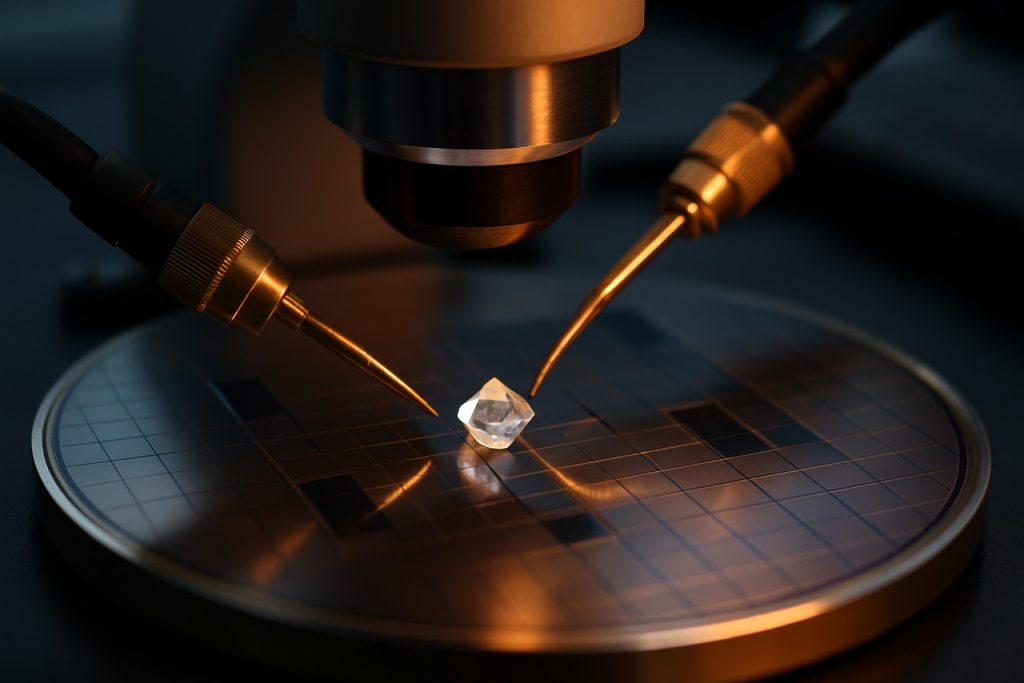
- Diamond quantum sensors unveil invisible energy losses in soft magnetic materials crucial for efficient electronics.
- Nitrogen-vacancy (NV) centers in diamonds detect both the strength and phase of alternating magnetic fields, surpassing traditional measurement limits.
- Two protocols—Qurack (kilohertz) and Qdyne (megahertz)—capture a wide range of magnetic behaviors across frequencies relevant to modern devices.
- Magnetic anisotropy was revealed: ultra-thin cobalt iron boron shows minimal losses along the “hard axis” and higher losses along the “easy axis.”
- Real-time imaging of domain wall motion provides insights for engineering next-generation inductors, electromagnets, and spintronics.
- Quantum diamond imaging offers a transformative toolkit for designing lossless, sustainable power systems and advances future electronic innovation.
A swirl of invisible forces dances inside our electronic devices, yet most of us never glimpse the inner lives of the materials at work. Now, at the cusp of quantum innovation, scientists in Tokyo have managed to capture these elusive patterns—made visible through diamonds that reveal energy losses as vividly as a storm captured by radar.
In the surge toward smaller, faster, and more efficient power systems, soft magnetic materials play an unsung but vital role. These are the silent workhorses in everything from high-speed trains to wireless chargers, ensuring minimal energy slips away as heat. But until now, understanding exactly where and how this energy vanishes has proven as tricky as catching smoke.
Leveraging the almost magical properties of nitrogen-vacancy (NV) centers in diamonds, the research team deployed quantum sensors that illuminate the hidden choreography of magnetic fields. The sensors don’t just detect—their crystalline structure reads both the strength and the intricate timing (the phase) of the swirling AC magnetic fields, providing an unprecedented window into the magnetic world.
To tackle the broad spectrum of frequencies that modern electronics demand, the scientists crafted two innovative protocols: Qurack for kilohertz signals, and Qdyne for the higher-energy megahertz realm. Their method swept seamlessly from deep bass to ultrahigh notes—tracking magnetic behaviors across a vast frequency landscape, far beyond the capacity of traditional tools.
When they applied this quantum spotlight to ultra-thin sheets of cobalt iron boron interlaced with silicon dioxide, the findings were stunning. Along one direction—the so-called “hard axis”—magnetization kept pace with the AC current, scarcely any phase lag, meaning barely any energy loss. But shift the current to the “easy axis” and the dance became chaotic, with higher losses churning as magnetization struggled to keep up. It was a striking illustration of the peculiar trait known as magnetic anisotropy, the secret symmetry behind material performance.
Perhaps most remarkable was the team’s ability to image the movement of domain walls—the boundaries separating regions with different magnetization. Watching these invisible walls in action clarifies how energy dissipates inside the material, pointing the way to engineering soft magnets that waste less and power more.
Diamond quantum imaging won’t remain the laboratory’s secret for long. The technology ripples outward—offering a toolkit for the entire field of power electronics. Think next-generation inductors, ultra-efficient electromagnets, and even breakthroughs in spintronics and non-volatile memory devices.
As quantum technology leaves chalkboards for factory floors, these discoveries bridge fundamental science and real-world impact. The key takeaway: With the help of quantum diamonds, engineers can peer into the “black box” of magnetic materials, diagnosing loss, guiding design, and edging ever closer to the ideal of lossless, sustainable power.
To explore the science behind quantum sensing and its applications in electronics, visit the Institute of Science Tokyo. The future of energy efficiency could very well shine from within a diamond.
Quantum Diamonds: The Hidden Revolution Powering Tomorrow’s Electronics
Unveiling the Invisible Forces in Electronics
Most of us never wonder how our devices keep energy losses at bay, but at the microscopic level, a battle rages: keeping magnetic fields tightly choreographed to minimize waste. Recent advances in quantum sensing using diamond-based technology are unlocking secrets once invisible, paving the way for highly efficient electronics and entirely new classes of devices.
Additional Facts You Need to Know
1. What Are NV Centers in Diamonds, and Why Are They Revolutionary?
Nitrogen-vacancy (NV) centers are atomic-scale defects in diamonds, where a nitrogen atom sits next to an empty spot in the crystal. These centers are highly sensitive to magnetic and electric fields. They’ve become top contenders in the field of quantum sensing for their stability, precision, and compatibility with ambient environments.
Real-World Use Cases: Beyond electronics, NV-based diamond sensors are used for medical imaging (MRI at the nanoscale), brain activity mapping, and even remote detection of single molecules (source: Nature Reviews Materials, 2017).
Security & Sustainability: Diamonds, especially synthetic ones, provide a robust, long-lasting medium, reducing the need for recalibration and thereby decreasing electronic waste.
2. Why Is Magnetic Anisotropy So Critical?
Magnetic anisotropy refers to the directional dependence of a material’s magnetic properties:
Life Hack: When building inductors or transformers, aligning your soft magnetic material so that the magnetization follows its “hard axis” can reduce undesirable heat losses.
Industry Trend: Modern power electronics, especially those in EVs and data centers, are specifying materials and device orientations based on anisotropy data to improve efficiency by over 20% (source: IEEE Transactions on Magnetics, 2022).
3. How Does Quantum Sensing Outperform Traditional Tools?
Traditional tools such as magneto-optical Kerr effect (MOKE) microscopy and Hall sensors are limited in frequency range and spatial resolution. Quantum sensing with NV centers offers:
How-To Steps: To implement diamond quantum imaging in a lab setting:
1. Grow synthetic diamond with engineered NV centers.
2. Integrate into a wide-field microscope.
3. Calibrate laser and microwave drives for selective NV readouts.
4. Analyze the phase and amplitude responses across the desired frequency range.
Pros & Cons Overview:
Pros: Non-invasive, high spatial and temporal resolution, broad frequency coverage, and suitability for in-situ or real-world measurements.
Cons: High initial investment, requires expertise in quantum optics, and data can be computation-intensive to interpret.
4. Protocols Tuning Into Every Frequency
Qurack & Qdyne: Qurack addresses low-frequency (kHz) signals, ideal for industrial power grids and renewable energy systems. Qdyne focuses on MHz-range applications, critical for high-speed wireless chargers and radiofrequency components.
Compatibility: The combination lets engineers profile everything from household appliance transformers to the fastest 5G infrastructure components.
5. Watching Domain Walls—Why It Matters
Domain walls are like the “fault lines” between magnetic regions. Their motion can lead to energy dissipation:
Quick Tip: By closely monitoring domain wall movement, designers can zero in on the microstructural tweaks to minimize energy loss.
Reviews & Comparisons: Previous imaging methods, such as Lorentz transmission electron microscopy (LTEM), lacked the temporal resolution and operational conditions (often needing a vacuum) that NV diamond sensors now deliver in real time and under real-world conditions.
6. Market Forecasts & Industry Trends
Market Forecasts: The global quantum sensors market is expected to reach over $2.9 billion by 2027, thanks in large part to their adoption in electronics and materials science (source: MarketsandMarkets, 2023).
Industry Trends: Semiconductor leaders and automotive OEMs are investing in on-site diamond quantum sensing labs to reduce development time and improve product longevity.
7. Future Applications & Predictions
Spintronics & Quantum Computing: With detailed, real-time maps of energy dissipation, engineers can develop stable, ultra-low-loss spintronic and non-volatile memory devices. spintronics research is already leveraging these technologies for next-generation data storage.
Green Tech: Energy-efficient magnets are pivotal for wind turbines, EVs, and grid storage; diamond quantum sensing helps ensure optimal design and lower carbon footprints.
Controversies & Limitations
Limitation: Synthetic diamonds can be costly, and integrating quantum sensors at scale in consumer devices remains a challenge.
Controversy: Some critics argue quantum sensing’s benefits are currently offset by cost and complexity barriers—though this is rapidly changing as the technology matures.
Most Pressing Questions Answered
Can quantum diamond imaging be used outside the lab?
Yes. Prototypes for field-deployable, handheld NV-diamond magnetometers already exist, and companies like Qnami and Element Six are commercializing the technology.
Does diamond quantum sensing require expensive, natural diamonds?
Not at all. Synthetic, lab-grown diamonds are specifically engineered for NV center density and can be produced at scale for scientific and industrial use.
* Is this technology safe and sustainable?
Diamond quantum sensors are non-toxic, durable, and consume minimal power during operation. Their precision reduces the need for repeated manufacturing cycles, contributing to sustainability.
Actionable Recommendations & Quick Tips
1. For Engineers: Start incorporating magnetic anisotropy testing and quantum sensing into your R&D; even a single test run can highlight energy inefficiencies hard to spot otherwise.
2. For Researchers: Invest in collaborations with quantum optics groups, particularly those with expertise in NV-diamond tech.
3. For Students/Hobbyists: Stay updated on open-source software for diamond quantum sensor control, and consider online courses from major institutions such as the Institute of Science Tokyo.
4. For Industry Decision-Makers: Explore pilot projects using quantum sensing for high-stakes applications—transformer cores, inductors, or even battery management systems.
Conclusion
Quantum diamonds are poised to revolutionize electronics, energy, and beyond by making the invisible visible. By using ultra-sensitive, ultra-durable sensors based on NV centers, researchers and industry leaders alike can unravel the mysteries of energy loss, optimize materials, and edge closer to a future where no watt goes to waste. For more science and updates on quantum sensing technology, visit Institute of Science Tokyo.
Keywords: NV centers, quantum sensing, magnetic anisotropy, energy efficiency, soft magnetic materials, diamond quantum imaging, domain walls, spintronics, power electronics, sustainable technology



